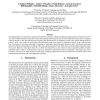LREC
2008
14 years 1 months ago
2008
This paper describes the Norwegian broadcast news speech corpus RUNDKAST. The corpus contains recordings of approximately 77 hours of broadcast news shows from the Norwegian broad...
LREC
2008
14 years 1 months ago
2008
Our paper focuses on the gain which can be achieved on human transcription of spontaneous and prepared speech, by using the assistance of an ASR system. This experiment has shown ...
LREC
2008
14 years 1 months ago
2008
The output of a speech recognition system is not always ideal for subsequent downstream processing, in part because speakers themselves often make mistakes. A system would accompl...
LREC
2010
14 years 1 months ago
2010
In this paper, we investigate the acoustic properties of phonemes in three speaking styles: read speech, prepared speech and spontaneous speech. Our aim is to better understand wh...
LREC
2010
14 years 1 months ago
2010
In this paper the FAU IISAH corpus and its recording conditions are described: a new speech database consisting of human-machine and human-human interaction recordings. Beside clo...
LREC
2010
14 years 1 months ago
2010
Investigating differences in linguistic usage between individuals who have suffered brain injury (hereafter patients) and those who haven't can yield a number of benefits. It...
COLING
2008
14 years 1 months ago
2008
This paper describes an incremental approach to parsing transcribed spontaneous speech containing disfluencies with a Hierarchical Hidden Markov Model (HHMM). This model makes use...
ICASSP
2009
IEEE
14 years 4 months ago
2009
IEEE
We consider the problem of word boundary detection in spontaneous speech utterances. Acoustic features have been well explored in the literature in the context of word boundary de...
TSD
2005
Springer
14 years 5 months ago
2005
Springer
Although speech, derived from reading texts, and similar types of speech, e.g. that from reading newspapers or that from news broadcast, can be recognized with high accuracy, recog...
ICMI
2005
Springer
14 years 5 months ago
2005
Springer
Situated, spontaneous speech may be ambiguous along acoustic, lexical, grammatical and semantic dimensions. To understand such a seemingly difficult signal, we propose to model th...



